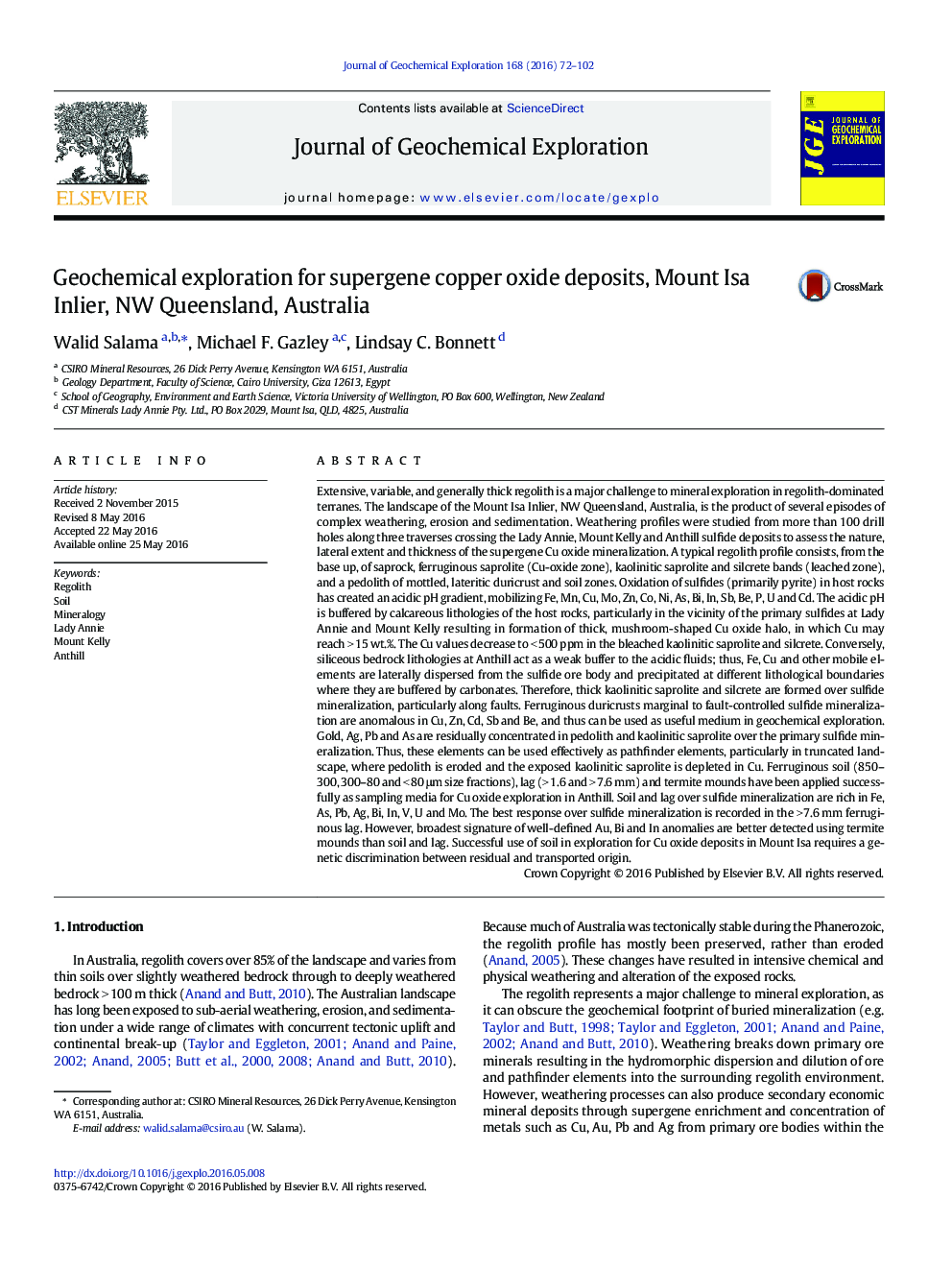| کد مقاله | کد نشریه | سال انتشار | مقاله انگلیسی | نسخه تمام متن |
|---|---|---|---|---|
| 4456944 | 1620891 | 2016 | 31 صفحه PDF | دانلود رایگان |

• The landscape of Mount Isa is a product of several episodes of weathering, erosion and sedimentation.
• Supergene Cu oxides are thick over fault-controlled sulphide deposits hosted in calcareous bedrock.
• Ferruginous soils and duricrusts are anomalous in Cu, but care is required for genetic interpretation.
• Soil anomalies can be diluted by recent gypsification and calcification of soil and saprolite.
• Termite mounds are anomalous in Au, Bi and In over the primary sulfide mineralization.
Extensive, variable, and generally thick regolith is a major challenge to mineral exploration in regolith-dominated terranes. The landscape of the Mount Isa Inlier, NW Queensland, Australia, is the product of several episodes of complex weathering, erosion and sedimentation. Weathering profiles were studied from more than 100 drill holes along three traverses crossing the Lady Annie, Mount Kelly and Anthill sulfide deposits to assess the nature, lateral extent and thickness of the supergene Cu oxide mineralization. A typical regolith profile consists, from the base up, of saprock, ferruginous saprolite (Cu-oxide zone), kaolinitic saprolite and silcrete bands (leached zone), and a pedolith of mottled, lateritic duricrust and soil zones. Oxidation of sulfides (primarily pyrite) in host rocks has created an acidic pH gradient, mobilizing Fe, Mn, Cu, Mo, Zn, Co, Ni, As, Bi, In, Sb, Be, P, U and Cd. The acidic pH is buffered by calcareous lithologies of the host rocks, particularly in the vicinity of the primary sulfides at Lady Annie and Mount Kelly resulting in formation of thick, mushroom-shaped Cu oxide halo, in which Cu may reach > 15 wt.%. The Cu values decrease to < 500 ppm in the bleached kaolinitic saprolite and silcrete. Conversely, siliceous bedrock lithologies at Anthill act as a weak buffer to the acidic fluids; thus, Fe, Cu and other mobile elements are laterally dispersed from the sulfide ore body and precipitated at different lithological boundaries where they are buffered by carbonates. Therefore, thick kaolinitic saprolite and silcrete are formed over sulfide mineralization, particularly along faults. Ferruginous duricrusts marginal to fault-controlled sulfide mineralization are anomalous in Cu, Zn, Cd, Sb and Be, and thus can be used as useful medium in geochemical exploration. Gold, Ag, Pb and As are residually concentrated in pedolith and kaolinitic saprolite over the primary sulfide mineralization. Thus, these elements can be used effectively as pathfinder elements, particularly in truncated landscape, where pedolith is eroded and the exposed kaolinitic saprolite is depleted in Cu. Ferruginous soil (850–300, 300–80 and < 80 μm size fractions), lag (> 1.6 and > 7.6 mm) and termite mounds have been applied successfully as sampling media for Cu oxide exploration in Anthill. Soil and lag over sulfide mineralization are rich in Fe, As, Pb, Ag, Bi, In, V, U and Mo. The best response over sulfide mineralization is recorded in the > 7.6 mm ferruginous lag. However, broadest signature of well-defined Au, Bi and In anomalies are better detected using termite mounds than soil and lag. Successful use of soil in exploration for Cu oxide deposits in Mount Isa requires a genetic discrimination between residual and transported origin.
Journal: Journal of Geochemical Exploration - Volume 168, September 2016, Pages 72–102